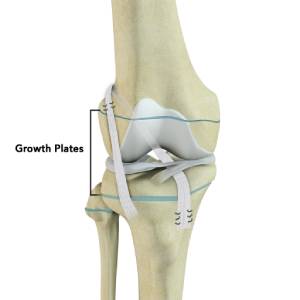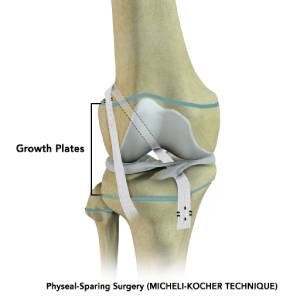Physeal Sparing Surgery (Micheli-Kocher Technique)
Physeal-Sparing Surgery
Surgery may be recommended to reconstruct a torn anterior cruciate ligament (ACL). In adults, reconstruction of the ACL typically involves passing a soft-tissue graft through tunnels drilled into the very top of the shinbone (tibia) and very bottom of the thighbone (femur) at the level of the knee joint. In a child or adolescent, such tunnels may damage the physes or growth plates (areas at the ends of long bones where growth is still occurring). A physeal-sparing technique may be recommended where the physes in the tibia and femur next the knee joint are left undisturbed, avoiding complications such as growth disturbance or angular deformity. If any tunnels in the bone are made, they are not made across the growth plate.
The Micheli-Kocher technique is a type of physeal-sparing approach that harvests and uses a part of the iliotibial band, or IT band, (band of tendon tissue that runs along the outside of your thigh, down to the knee) to reconstruct the ACL. It is a combined intra-articular (inside the joint) and extra-articular (outside the joint) reconstruction technique, in which the IT band strip rather wraps around and through the joint to mimic the function of the native ACL.

Indications for Physeal-Sparing Surgery
Orthopedic surgeons may recommend ACL reconstruction for active children and adolescents who are involved in sports or recreational activities. Because knee instability due to an ACL tear can lead to meniscal and cartilage injuries and early onset of arthritis, ACL reconstruction is designed not only to allow patients to have improved knee stability for cutting and pivoting activities, like sports, but also as an act of joint preservation, to prevent other injuries to structures in the knee joint.
Physeal-sparing surgery is preferred for children with significant growth remaining in the legs, such as boys 13 years-old and under and girls 12 years-old and under.
Benefits of Physeal-Sparing Surgery Described by Micheli-Kocher
The benefits of the procedure include:
- Avoidance of injury to the physes (growth plates), minimizing the risk of growth disturbance, leg length abnormalities and angular deformities
- Cartilage and meniscal damage is minimized due to improved knee stability
- Low revision rate and excellent post-operative functional outcomes
How to Prepare for Physeal-Sparing Surgery
Your doctor may recommend using a brace to provide improved stability while the knee partially recovers from the initial injury and possibly allow healing of other knee ligaments before surgery is performed. You may need to undergo physical therapy to improve range of motion and allow knee swelling to go down. If the knee is stiff or swollen at the time of surgery, restoring range of motion may be difficult after the surgery, which could affect the success of the procedure. You may be given specific instructions on ‘do’s’ and ‘don’ts’ before and on the day of your surgery. Instructions may include details on food intake, medication, etc.
How the Micheli-Kocher Technique Works
Your surgeon harvests and uses a strip of the IT band as a graft for ACL reconstruction.
During the procedure:
- An incision is made on the lateral aspect (outside) of the knee to access the IT band and other incisions are made next to the knee joint.
- A strip of IT band is isolated by cutting a central part of the IT band. The lower end of the strip remains attached to the tibia and the upper end is freed.
- The upper end of the strip is brought around the lateral femoral condyle (a part on the lower end of the femur) and enters the knee through the notch or space between the posterior femoral condyles.
- The IT band strip is secured to the knee joint capsule and periosteum (the lining of a bone) of the outer or lateral femoral condyle with sutures (extra-articular reconstruction)
- The free end of the IT band strip is passed out to the front of the knee where it is sutured to the periosteum of the upper tibia just below the knee joint.
Micheli-Kocher physeal-sparing surgery is thus performed without drilling any tunnels through the bone.

Risks Associated with the procedure
The drawbacks of this technique include:
- Technically demanding (requires prior experience/expertise with this technique)
- Rupture of reconstructed ACL due to increased stress on the graft
- Scar tissue formation restricting joint movement
Recovery after Physeal-Sparing Surgery
Rehabilitation is very important to help you return to your regular activities and sports. You will work with a physical therapist to help you safely achieve these goals. Therapy is initiated within 1-2 weeks following surgery and will focus on improving range of motion and strength. You will have to adhere to certain activity limitations initially. As you progress with therapy the focus shifts towards improving balance and neuromuscular control. At 3 months, you may be able to jog, and agility exercises and sport-specific training can safely be introduced after 6 months. Special training to optimize movement patterns during athletics can help prevent future knee injuries, such as re-tear of the ACL graft.
